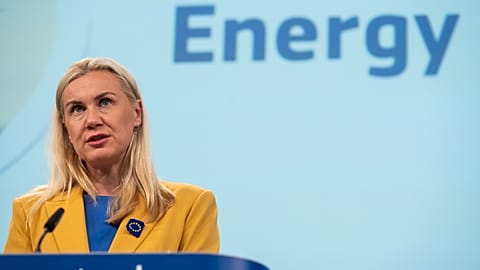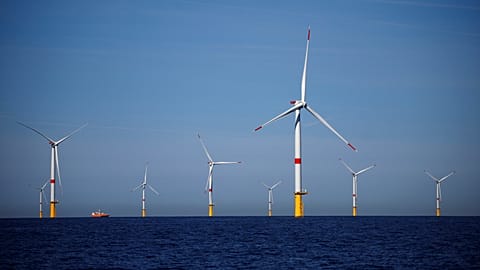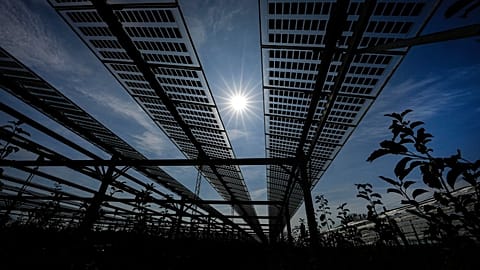How is the EU pushing wind energy to meet its 2030 green energy targets and what challenges hinder its expansion? We look at how member states are contributing and what strategies are in place.
In its effort to reduce carbon emissions, the European Union has set ambitious targets for 2030, and renewable energy sources are key to meeting these objectives.
In 2022, the European Commission raised its target of having at least 32% of renewables in its energy production by 2030 to a minimum of 42.5%, intending to ultimately achieve 45%.
But while the EU’s renewable energy capacity has been growing consistently - even surpassing the goal to reach 20% by 2020 - the bloc still has a long road ahead.
According to the latest data available, the current share of renewables in Europe’s energy production is 23%, which means the bloc will need to nearly double its capacity in less than six years to achieve the new 2030 target.
Boosting wind energy is a major part of the plan as it is one of the most efficient renewable power sources.
Compared to solar panels, wind turbines emit less CO2 into the atmosphere, consume less energy, and produce more energy overall.
In fact, one wind turbine can generate the same amount of electricity per kWh as approximately 48,704 solar panels.
This is in part because solar panels stop producing at night, explains Giles Dickson, CEO of WindEurope, one of the largest wind energy networks in the world.
“Solar PV has an average capacity factor [i.e. an average output] of 20%, even in Spain or Italy, because at night there is nothing, so you discount all that,” he says.
“So, you get more bang for your buck from one unit of wind capacity than one unit of solar capacity.”
How much of the EU's electricity is generated by wind power?
In 2022, wind power accounted for over one-third of the total electricity generated from renewables. And, for the first time, wind and solar PV combined surpassed electricity generation from gas and nuclear sources.
That year, wind energy alone covered more than 16% of the EU's total electricity needs.
The share of wind power in a country's energy production varied greatly from one member state to another.
Only eight countries were above the EU’s 16% average in 2022, with Denmark well ahead.
Despite a modest wind infrastructure compared with larger EU countries, the small Scandinavian country exceeded expectations by meeting more than half of its electricity needs in 2022 thanks to wind power.
Ireland followed, with 34% of its electricity needs met by wind energy in the same period.
Germany – home to Europe's largest wind turbine park – shared the third place with Portugal, both countries covering 26% of their energy needs through wind energy.
In 2023, Ireland achieved a groundbreaking milestone,with wind turbines supplying 70% of the island's electricity for over 11 consecutive hours.
Portugal also marked a significant achievement in 2023 with 149 consecutive hours of renewable energy, surpassing the country’s consumption needs by 262 GW.
How are countries contributing to the development of wind power in the European Union?
Germany was the frontrunner in 2022, with its total wind production capacity reaching over 66 GW.
Spain also ranked among Europe's significant wind installations, with over 29 GW of capacity in 2022.
The two countries together represent nearly half of the EU’s total production capacity.
Overall, the EU's wind energy production capacity reached an all-time high of 204.5 GW in 2022, making up more than 23% of the global capacity.
That year, the number of new wind installations increased by 47%, with the addition of 16 GW of wind power capacity.
However, this figure is still far from the EU’s 2030 green energy target.
Ultimately, the EU aims for wind energy to make up 35% of all electricity consumed by 2030 and over half by 2050.
“That requires a major build-out of wind farms both onshore and offshore but the technology is improving, one wind turbine today is producing more electricity than it used to produce 20, 30 years ago when wind energy started,” explains Dickson.
According to WindEurope, to reach its goal, the bloc will need to havea wind energy production capacity of 420 GW by 2030. This implies adding at least 30 GW of wind capacity per year until then.
In 2022, Germany, Sweden, and Finland led in onshore wind installations, making up 40% of all new installations.
Germany also built the most offshore farms, along with the Netherlands, while France installed its first large offshore wind farm.
However, offshore potential remained largely untapped,with 87% of new wind installations built onshore that year.
Overall, 92% of the current installed capacity in the EU is onshore, while offshore installations make up the remaining 8%.
But things are starting to pick up in offshore wind power.
How is offshore growing in the EU?
In 2023, the European Union experienced its most successful year on record for new offshore wind installations.
During this period, the bloc constructed a total of 3 GW of offshore wind capacity, an increase of 2.1 GW compared to 2022.
Overall, 17 GW of wind power was added in 2023 between offshore and onshore.
“Wind power is now 19% of all the electricity we consume,” says Dickson. “And nearly all of the wind farms that we build in Europe are built with equipment made in Europe. We’re a very strong manufacturing industry, we have more than 250 factories all over Europe making wind turbines and components for them.”
The Netherlands and France led in offshore wind farm installations, with notable projects including the 1.5 GW Hollandse Kust Zuid, now recognized as the largest operational offshore wind farm in the world.
Offshore investments also soared across Europe in 2023,reaching an unprecedented €30 billion. These investments will facilitate the development of 9 GW of new offshore capacity in 2024.
The surge follows a sharp decline in 2022 when funding plummeted to an all-time low of €0.4 billion due to permitting bottlenecks and rising supply chain costs.
In response to these challenges, the European Commission introduced its Wind Power Package in 2023 to simplify permitting.
In the last 18 months, European countries have introduced more policy and regulatory changes to ease permitting than over the entire previous decade.
According to WindEurope’s CEO, the new rules have led to the number of permits awarded in Germany and France increasing by 70% last year compared to 2022.
The action plan also set out a series of measures to help finance investments in new factories, infrastructure, and the wind energy workforce.
Thanks to new investments, several supply chain factories are being built – or are in the pipeline – in Denmark, the Netherlands, Germany, Spain, and Poland.
“We need to accelerate the permitting process so more wind farms get built, we need to expand the supply chain and expand the grid infrastructure,” explains Dickson.
“We also need to accelerate the rate at which we build out the grid connections because it’s one thing to build the wind farms, but you have to connect them to the energy consumers too.”

















